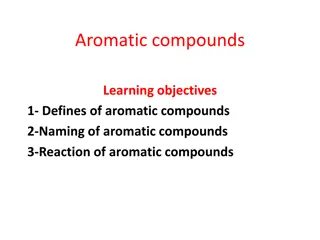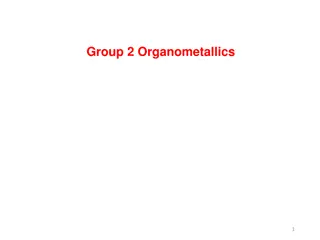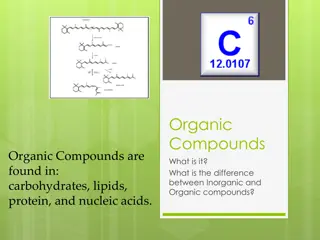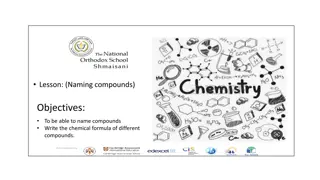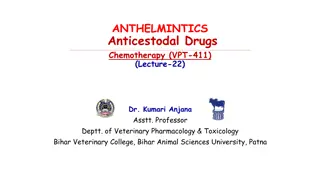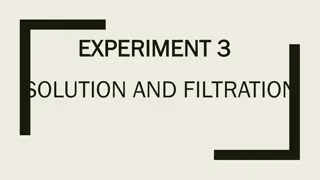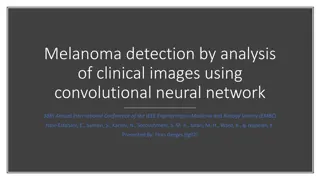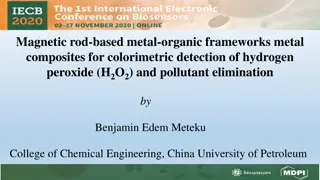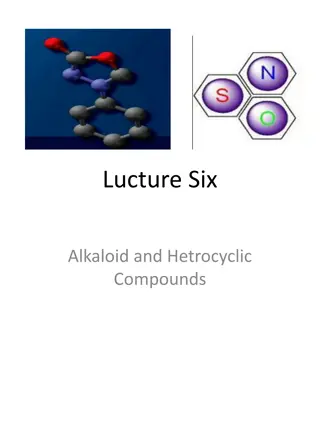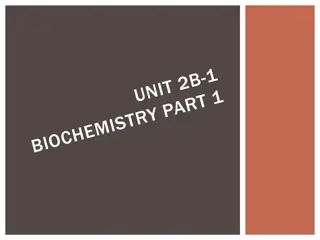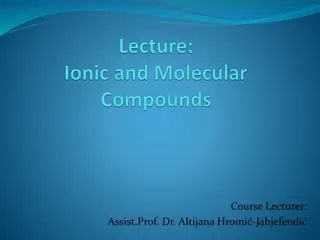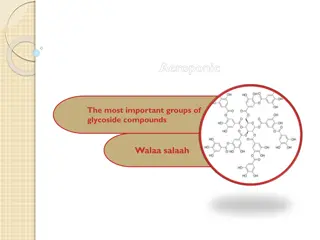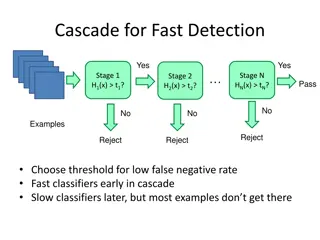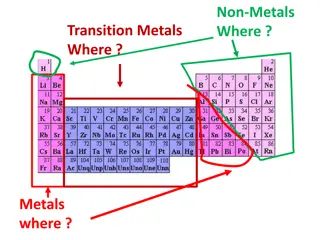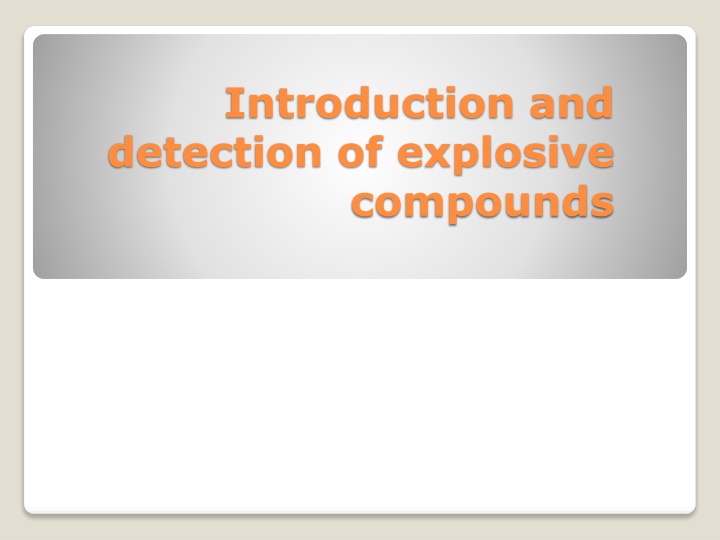
Understanding Explosive Compounds: Detection and Safety
Explore the world of explosive compounds, from their chemical composition to detection methods and safety measures. Learn about the risks associated with explosives and the importance of proper investigation in explosion cases. Stay informed about advancements in detectors and the responsibilities of security officers in the event of blasts. Are we truly safe from these threats?
Download Presentation

Please find below an Image/Link to download the presentation.
The content on the website is provided AS IS for your information and personal use only. It may not be sold, licensed, or shared on other websites without obtaining consent from the author. If you encounter any issues during the download, it is possible that the publisher has removed the file from their server.
You are allowed to download the files provided on this website for personal or commercial use, subject to the condition that they are used lawfully. All files are the property of their respective owners.
The content on the website is provided AS IS for your information and personal use only. It may not be sold, licensed, or shared on other websites without obtaining consent from the author.
E N D
Presentation Transcript
Introduction and detection of explosive compounds
Some questions for you: Do explosives burns or blast? What is explosive train? What are home made bombs? Are our aviations securities secure? Which is the most advanced detector? What if you as an chief security officer hear about the blast in your region? Your duties Why proper investigation is necessary in explosion cases?
"bomb blast" triggered by Maoists on the rail track caused the derailment of the Howrah-Kurla express train Ajmer Blast
Explosives and Explosions The Chemistry of High Energy Organic Compounds
What is an Explosion? Rapid burning of a material resulting in a sudden build-up and release of heat and gas pressure.
Explosive compounds Explosives are chemical compounds or mixtures which will on application of an external stimulus heat, shock, friction or ignition undergo a rapid chemical decomposition. The chemical reaction results in sudden release of large amount of energy due to liberation of gas and temperature. The pressure thus generated is thrust out equally in all directions. All explosive compounds can be considered to be composed of three components namely Fuel, Oxidizer and Sensitizer.
Explosive Train An arrangement of a series of combustible and explosive elements consisting of a primer, a detonator, a delay, a relay, a lead and booster charge, one or more of which may be either combined with another element or omitted. The function of the explosive train is to accomplish the controlled augmentation of a relatively small impulse into one of sufficient energy to cause the main charge of the munition to function. A train of combustible and explosive elements arranged in order of decreasing sensitivity. The explosive train accomplishes the controlled augmentation of small impulse into one of suitable energy to actuate the main charge. Delay fuse_> shell leader_> lifting charge_> shell delay _> bursting charg e_> star prime_> star.
Elements of the Explosive Train Low Energy Initiating Device in the old days matches, these days electric or shot shell primer. Distance element old days safety fuse, these days electric cable, signal tube, radio frequency. Detonator converts the low energy into an explosive shock wave. Can incorporate delays. Booster / Primer detonator sensitive explosive to amplify the detonation shock wave. Main Charge the bulk of the explosive device.
a) Explosives are classified into: a) Explosives are classified into: Miscellaneous Low Explosives High Explosives Initiator Intermediates Main fillings Demolition & Blasting Pyro tech Compositions Incendiary Compositions Smoke compositions
Black powder (gun powder): Black powder possibily the oldest explosive used today mainly as an igniter for NC gun propellants and to some extent in safety blasting fuses, delay fuse, signal and distress rockets and in fire crackers. It is also used for mining when a lower power explosive is used. The composition of black powder: Potassium nitrate + charcoal + sulphur in the ratio 75:15:10. Sodium nitrate + charcoal + sulphur Sulphurless powder : Potassium nitrate + charcoal Ammonium powder : Potassium nitrate + Ammonium nitrate + charcoal
Smokeless powder: It is the most widely used propellant based on NC. Propellants containing only plasticised NC as energy source are called single based propellants. (NC+ Stabilizer e.g. Diphenyl amine (DPA). Double based propellants contain NC + nitroglycerine and a stabilize (DPA) such as NC, NG &. Stabilizer as DPA. Triple base propellants incorporate also a crystalline explosive such as nitro guanidine. (Propellants also contain stabilisers, plasticisers and coatings and some times a burning modifier. Triple base propellants contain along with NC, ONG another, crystalline explosive (nitroguanidine) plus plasticizer, coatings and sometimes a burning modifier.
Mercury fulminate : Mercury fulminate is a heavy non hygroscopic crystalline solid. It is thermally unstable and very sensitive to impact, friction, spark, flame and shock when dry. It reacts with metals such as aluminium, magnesium, zinc, brass and bronze in moist atmosphere. Being a mercury derivative, it is a toxic compound. Practically insoluble in water Colourless crystals Empirical formula: C2N2O2Hg Molecular weight: 284.6 Deflagration point: 1650C Impact sensitivity: 0.1-0.2 kp m
Lead azide: Pb(N3)2 Lead azide has a high temperature of ignition and less sensitive to shock and friction than mercury fulminate. It has good stability to heat and storage. Due to its high temperature of ignition it is generally used in primary mixtures with lead styphnate which is very easy to ignite. Its contact with copper must be avoided because It leads to the formation of copper azide. Since it is a non conductor it may be mixed with flaked graphite to form a conductive mixture for use in low energy electrical detonator. Insoluble in water Colourless crystals Molecular weight: 291.3 Deflagration point: 320 - 3600C Impact sensitivity: 0.25 0.4 kp m
Ammonium nitrate: It had been an ingredient in explosive since the earliest days primarily as an oxidizer in NG dynamite mixtures. Readily soluble in water. Colourless crystals Molecular weight: 80.0 Impact sensitivity: Upto 5 kp m Melting point: 169.60C Deflagration point: 169.6-2100C Ammonium nitrate- Fuel oil (ANFO): These mixtures are made of porous prills of ammonium nitrate (94%) soaked in fuel oil. In some cases aluminium is added to increase the explosive strength. These explosives are inexpensive and safe to handle but low in explosives strength and detonation velocity. They cannot be used in presence of water.
Slurry explosives water gels: These explosives are made of aqueous solutions of ammonium nitrate and sodium or calcium nitrate, gelled by the addition of guar gum or cross linking agents. They are sensitised by nitro explosives or organic amine nitrates. Combustible materials such as Al, urea, sugar or glycol are mixed with these solutions. The cross linking agents form a chemical bond. Typical slurry explosives contain ammonium nitrate (30 70% 0, Sodium nitrate ( 10-15%), calcium nitrate(15-20%), aliphatic amine nitrate upto 40%, Al ( 10-1L%), TNT or other explosives sensitisers (5-15%), gellants (1-2%), stabilisers (0.1- 2%), ethylene glycol (3-15%) and water (10-20%). (ref 2, page 9 & ref 3, page 21)
Picric acid (2,4,6-trinitrophenol ): It was used in large caliber shells in world war I. In world war II a mixture of ammonium picrate and TNT was widely used in the press loading of armour piercing shells. Soluble in hot water and readily soluble in alcohol, ether, benzene and acetone. Yellow crystals Empirical formula: C6H3N3O7 Molecular weight: 229.1 Deflagration point: 3000C Impact sensitivity: 0.75 kp m Solidification point: 122.50C
TNT (2,4,6-trinitrotoluene) : It is the most widely used military explosives. Its main features include low melting point, stability, low sensitivity to impact, friction and high temperature and its relative safe methods of manufacture. Almost insoluble in water, sparingly soluble in alcohol and soluble in benzene, toluene and acetone. Pale yellow crystals; if granulated; flakes. Empirical formula: C7H5N3O6 Molecular weight: 227.1 Deflagration point: 3000C Impact sensitivity: 1.5 kp m Solidification point: 80.80C
Tetryl (2,4,6-trinitrophenylmethylnitramine ) It is used in military boosters Practically insoluble in water, sparingly soluble in alcohol, ether and benzene and is more readily soluble in acetone. Pale yellow crystals. Empirical formula: C7H5N5O8 Molecular weight: 287.1 Deflagration point: 1850C Impact sensitivity: 0.3 kp m
PETN (pentaerythritol tetranitrate): It is used as a base charge in blasting caps and detonators as the core explosives in detonating cord, in booster charges, in plastic explosives, and as an ingredient in other explosives. The chemical stability of PETN is very high and is considered to be more stable than all other nitrate esters. Insoluble in water, sparingly soluble in alcohol, ether and benzene and soluble in acetone and methyl acetate. Colourless crystals. Empirical formula: C5H8N4O12 Molecular weight: 316.1 Deflagration point: 2020C Impact sensitivity: 0.3 kp m Melting point: 141.30C
RDX (cyclotrimethylene trinitramine): It is also known as cyclonite and hexogen. It is one of the most important military explosives used today. It has high chemical stability lower than that of TNT and an explosive power much greater than TNT.RDX is considerably more susceptible than TNT to shock detonation. RDX is used as a component in mixtures with other explosives such as TNT and as a plastic explosives. A well-known plastic explosive, Semtex is based on RDX and PETN. Mixtures of RDX and wax are used for booster charges in many military ammunition especially in artillery shells
Soluble in acetone, insoluble in water and sparingly soluble in ether and ethanol. Cyclo hexanone, nitrobenzene and glycol are solvents at elevated temperatures. Colourless crystals. Empirical formula: C3H6N6O6 Molecular weight: 222.1 Impact sensitivity: 0.75 kp m Melting point: 2040C
Characteristics of high and low explosives Characters High explosives Low explosives Method of initiation Primary explosives by ignition and Secondary explosives by detonation By ignition Time conversion of explosive to gaseous products Velocity of consumption of explosives grains of complete Micro seconds Milli seconds 1.5 to 10 km s-1 Few centimeters to meter s-1 Velocity of flame front 1.5 to 10 km s-1 0.5 to 1.5 km s-1 Demolition Excellent to poor Nil Velocity Detonation(VOD) of More than 1000 m s-1 Less than 1000 m s-1
Improvised Explosive Devices ( IEDs) IEDs: bombs are not manufactured by any fixed standards, therefore their materials of construction, composition of ingredients varies widely. Everything depends upon the availability of resources, knowledge and skill of user. Explosives composition The various ingredients include the various combinations of oxidizer and fuel. 1) Potassium chlorate + Arsenic sulphide + missiles (iron nails, glass pieces , stone chips etc.,) - Throw down device. 2) Potassium chlorate + sugar initiated by conc., Sulphuric acid - Acid bomb
Improvisation can be made on container, main charge, initiation device and projectiles depending upon the availability, skill, motive and means. For example: 2.2.1.2Container; Tiffin carrier, transistor, cement pipe, iron pipe, telephone, Television, toys, cell-phone, computer, scooter, cycle, the articles which are easily available to the anti social elements. 2.2.1.3 Main charge : High explosives, Low explosives or combinations. 2.2.1.4 Initiation device: Time device, remote device and impact device, battery operated etc.
COUNTRY MADE BOMBS 1. Molotov Cocktails 2. Chemical explosives 3. Accidental Explosives 4. Flame able Compounds 5. Smoke producing compounds 6. Circuit explosions
Explosive detection / Bomb squad equipment 1.MO-2M MO-2M is a hand-held explosive vapor detector capable of detecting trace amounts of explosives. Used in screening people, luggage, cargo, vehicles and buildings. Lightweight Real time sampling and analysis Very high sensitivity
2. RFD-23 The portable non-linear junction (NLJ) detector RFD-23 is intended for search and detection of devices containing semiconductor components such as: electronic fuzes of explosive devices, radio microphones, including those remote controlled, microphone amplifiers, devices for covering data acquisition in IR, concealed recording device. The RFD-23 detects devices switched on as well as switched off .
3.Barrikada-2 Now a days replaced by Sizo Mobile Barrikada-2 is a portable radio frequency jamming device designed to deny the activation of explosive devices by remote control. Operates in both stationary and mobile modes
Metal Detectors 1.OVERTONE Overtone is a hand-held metal detector designed to screen people for concealed metal objects. Widely used for theft prevention and security applications. Detects and discriminates between ferrous and non-ferrous objects Audible and visible indicators of different tones and colors Two sensitivity levels
2.MOLE Mole is a hand-held metal detector designed to search for objects buried underground or under shallow water. Applications range from scientific (archaeology) to utility; law enforcement and land mine detection. Highly sensitive metal detector capable of detecting and locating ferrous and non ferrous objects, low metal content objects as well as non-metallic objects such as plastic land mines. Indicates object type, depth and dimension Ground compensation to adapt to various types of terrain Three detection modes (all metal, selective metal mode, Hodogram mode) Audio alarm and large graphic display for size, depth, orientation of objects
3.RUBIKON The Rubikon is a multi-zone archway metal detector designed to screen people for concealed weapons at control gates
Technical Surveillance Countermeasure RFD-23 Wireless Security Communicator /PDA TACTOP notification system for which we will provide a wireless communication platform able to handle multimedia information (data, voice, video) in a secure wireless network environment.
SXR-150 The portable X-Ray inspection system SXR-150 is designed for the inspection of suspect objects in the field. Typical applications include: Inspection of luggage, parcels or mail packages, Screening of vehicles for search of concealed weapons or explosive devices, Inspection of premises, office equipment, communication facilities, furniture, walls for search of concealed objects and contraband, Criminal investigation and expertise.
CTX-9000 (computer tromography) The CTX-9000 is an automated explosives detection system that uses computed tomography to characterize materials in checked bags and automatically identify objects that could be improvised explosive devices. The CTX-5500DS is the most widely used, FAA-certified Explosives Detection System in the world. It can be used for either standalone applications or in an integrated manner with airport baggage handling systems. It can also be configured to detect other types of contraband material.
The CTX-5500DS has an FAA-certified throughput of 384 bags per hour. Its Dynamic Screening (DS)capability offers flexibility by allowing manual or automatic switching between various screening modes.
Crime Scene Management Information Management Manpower Management Technology Management Logistics Management
Steps to the scientific examination of a crime scene Recognition Scene survey Documentation Collection and preservation Identification Comparison testing Individualization Evaluation Interpretation Reconstruction Reporting and presentation
Crime Scene Investigation Models Model Type Description Advantages Disadvantages Patrol officers and detectives serve as crime scene technicians Useful if resources and demand are relatively low Minimal experience and time commitment; conflicts with regular duties Traditional Specially trained full- time civilian personnel Continuity, specialization, scientific and technical training Minimal investigative experience; no global view of investigation Crime scene technicians Full-time, sworn officers Primary assignment; increased experience Transfers out of unit may deplete investigation resources; only for major cases Major crime squad Laboratory scientists Superior technical and scientific skills; knowledge of current methods No investigative experience; depletes lab resources Lab crime scene scientist Police, technicians, lab personnel, medical examiners, and prosecuting authorities Advanced scientific, technical and investigative resources; shared responsibilities Requires extensive resources, comprehensive procedures, and continual communication Collaborative team
Duties of First Responding Officer Assist the victim. Search for and arrest the suspect if still on the scene. Detain all witnesses. Protect the crime scene. Note and communicate to crime scene investigators all movements and alterations made to the crime scene. 1. 2. 3. 4. 5.
Science at a Crime Scene Observing Using one or more of your senses to gather information FYI: There may be more than one hypothesi s for a given set of facts. Inferring Offering a reasoned opinion based on observations and experience Predicting Stating an opinion about what will happen in the future Developing a Hypothesis A possible explanation for a set of observations
Securing the Crime Scene Level 1: Overall scene security for restriction of general public. ****To prevent changing or alteration of the scene Contamination. Level 2: Restriction to Official business Level 3: Target area
Crime Scene Survey Walk-Through : Preliminary crime scene survey performed to orient the crime scene investigator to the scene and the physical evidence at the scene.
Guidelines to follow in a walk-through Use the walk-through to mentally prepare a reconstruction theory that can and should be changed as the scene investigation progresses. 2. Note any transient (temporary) or conditional (the result of an action) evidence that requires immediate protection and processing. 3. Be aware of weather conditions and take precautions. 4. Note all points of entry or exit and paths of travel within the scene. (Be aware of alteration or contamination made by the first responder) 5. Record initial observation of who, what, where, when, and how 6. Assess the scene for personnel, precautions, or equipment that will be needed. 1.
Crime Scene Documentation Take notes at the crime scene. Videotape the crime scene. Photograph the crime scene. Sketch the crime scene. 1. 2. 3. 4.
Taking notes Provides a written record of all of the crime scene activities. Taken as activities are completed.
Videotaping Gives a three-dimensional portrayal of the scene. Should follow the scene survey.
Photographing Provides a true and accurate pictorial record of the crime scene and physical evidence present. MAKE SURE YOU WRITE DOWN THE GUIDELINES FOR PHOTOGRAPHY ON PAGE 1.

